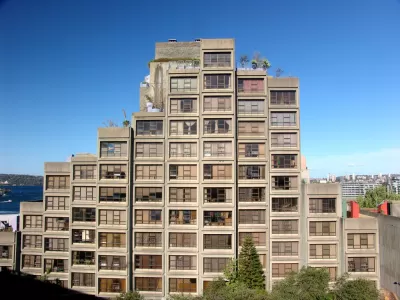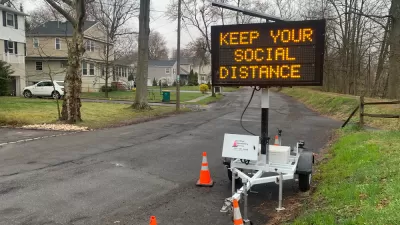Rising land values has made some of the land Sydney, Australia's affordable housing sits on prime targets for redevelopment and gentrification.

Residents in some of Sydney's public housing are being forced out of their homes as the city looks to sell off the land to fund new housing development elsewhere. The South China Morning Post reports that public housing in the suburbs of Red Fern, Millers Point, and Waterloo are all scheduled for redevelopment, leaving many of their residents feeling unmoored from the communities they have lived in for years. The sell-off is part of a government strategy to increase density on the site of the public housing, taking advantage of the steep increase in property values to help fund new public housing in other locations. The Morning Post article notes that after Hong Kong, Sydney is the second least affordable housing market in the world.
This has sparked a government strategy affecting Millers Point and Waterloo: trade valuable inner-city social housing – never quite as dense as it could be, occasionally in disrepair – for newer, cheaper, more numerous housing elsewhere, easing the state’s 60,000 person-strong waiting list.
According to the state government, the sale of Millers Point alone will raise A$500 million and fund 1,500 new social housing dwellings in the city’s outer western suburbs. But to many, surging rents and the public eradication of the city’s few high-profile housing estates give the impression that inner Sydney is no longer a place where poorer people can live.
The government has promised that all of the residents will be able to return to the neighborhood once redevelopment is complete, however many are worried that the services they have relied on, including drug counseling services, will have no home in the newly gentrified community.
FULL STORY: Sydney’s last stand: the residents holding out against gentrification

Alabama: Trump Terminates Settlements for Black Communities Harmed By Raw Sewage
Trump deemed the landmark civil rights agreement “illegal DEI and environmental justice policy.”

Planetizen Federal Action Tracker
A weekly monitor of how Trump’s orders and actions are impacting planners and planning in America.

The 120 Year Old Tiny Home Villages That Sheltered San Francisco’s Earthquake Refugees
More than a century ago, San Francisco mobilized to house thousands of residents displaced by the 1906 earthquake. Could their strategy offer a model for the present?

LA’s Tree Emergency Goes Beyond Vandalism
After a vandal destroyed dozens of downtown LA trees, Mayor Karen Bass vowed to replace them. Days later, she slashed the city’s tree budget.

Sacramento Leads Nation With Bus-Mounted Bike Lane Enforcement Cameras
The city is the first to use its bus-mounted traffic enforcement system to cite drivers who park or drive in bike lanes.

Seattle Voters Approve Social Housing Referendum
Voters approved a corporate tax to fund the city’s housing authority despite an opposition campaign funded by Amazon and Microsoft.
Urban Design for Planners 1: Software Tools
This six-course series explores essential urban design concepts using open source software and equips planners with the tools they need to participate fully in the urban design process.
Planning for Universal Design
Learn the tools for implementing Universal Design in planning regulations.
Ada County Highway District
Clanton & Associates, Inc.
Jessamine County Fiscal Court
Institute for Housing and Urban Development Studies (IHS)
City of Grandview
Harvard GSD Executive Education
Toledo-Lucas County Plan Commissions
Salt Lake City
NYU Wagner Graduate School of Public Service





























